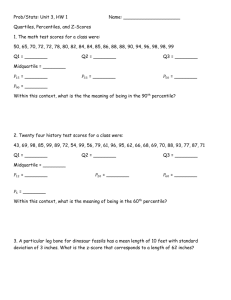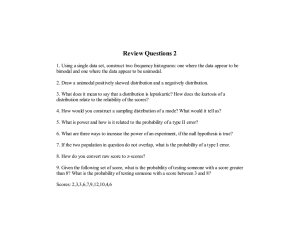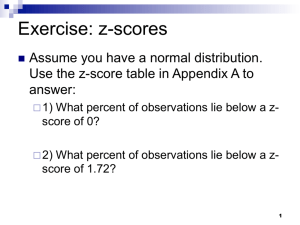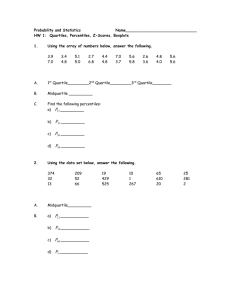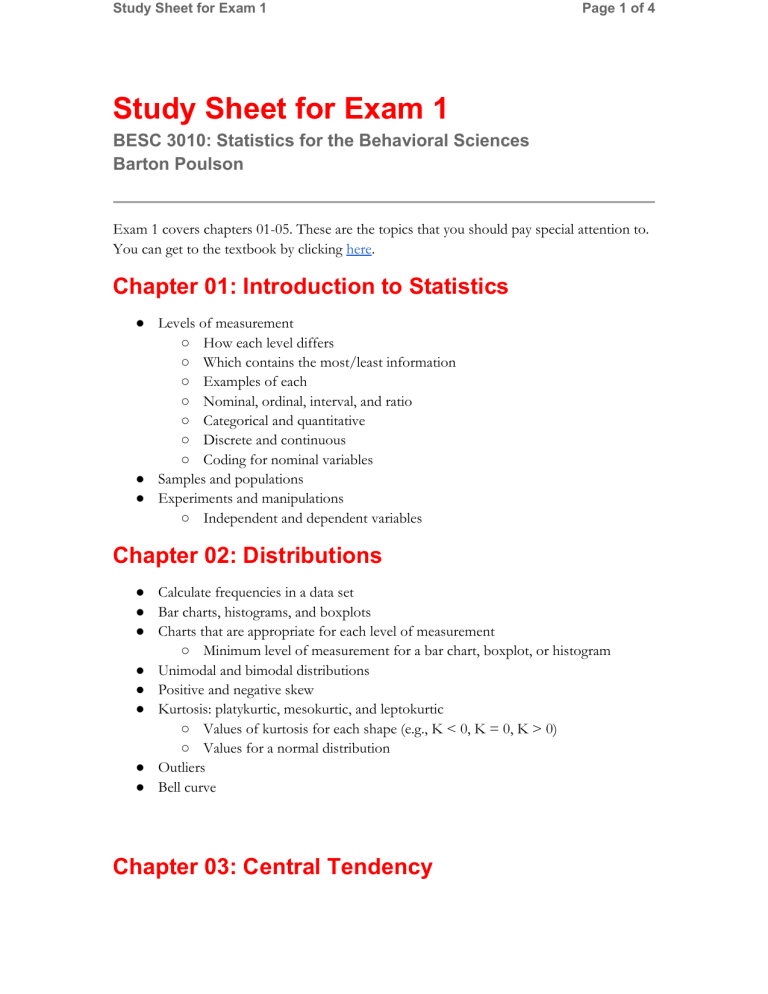
Study Sheet for Exam 1 Page 1 of 4 Study Sheet for Exam 1 BESC 3010: Statistics for the Behavioral Sciences Barton Poulson Exam 1 covers chapters 01-05. These are the topics that you should pay special attention to. You can get to the textbook by clicking here. Chapter 01: Introduction to Statistics ● Levels of measurement ○ How each level differs ○ Which contains the most/least information ○ Examples of each ○ Nominal, ordinal, interval, and ratio ○ Categorical and quantitative ○ Discrete and continuous ○ Coding for nominal variables ● Samples and populations ● Experiments and manipulations ○ Independent and dependent variables Chapter 02: Distributions ● Calculate frequencies in a data set ● Bar charts, histograms, and boxplots ● Charts that are appropriate for each level of measurement ○ Minimum level of measurement for a bar chart, boxplot, or histogram ● Unimodal and bimodal distributions ● Positive and negative skew ● Kurtosis: platykurtic, mesokurtic, and leptokurtic ○ Values of kurtosis for each shape (e.g., K < 0, K = 0, K > 0) ○ Values for a normal distribution ● Outliers ● Bell curve Chapter 03: Central Tendency Study Sheet for Exam 1 Page 2 of 4 ● Mode, median, and mean ○ Calculate each for a data set ● Minimum levels of measurement needed for each measure ● How each is affected by skewness and outliers ○ When each measure works best ● Which measures will be highest or lowest in a skewed distribution Formulas for Chapter 03 ● 𝜇, the population mean: 𝜇 = 𝛴𝑋 𝑁 ● 𝑋 = M = the sample mean: 𝛴𝑋 𝑋= 𝑀= 𝑛 Chapter 04: Variability ● How to calculate the range for a data set ○ Uses of the range ● How to calculate the IQR (interquartile range) for a data set ● How to calculate the variance and standard deviation for populations and samples ● Why samples have different formulas that population ● Degrees of freedom ● Deviation values (or deviation scores) ● Sensitivity of each measure to outliers ● Effects of open-ended and undefined scores ● What it means when variability statistics are high vs. when they are low ● Kurtosis: platykurtic, mesokurtic, and leptokurtic (this was also in chapter 02) ○ Values of kurtosis for each shape (e.g., K < 0, K = 0, K > 0) Formulas for Chapter 04 ● The range (same for population and sample): Range = Xmax – Xmin Range = Q4 – Q0 ● The IQR (same for population and sample): IQR = Q3 – Q1 Study Sheet for Exam 1 Page 3 of 4 ● Degrees of freedom (for the sample variance and standard deviation): df = n - 1 ● The population variance: 2 𝜎 𝛴(𝑋 − 𝜇)2 = 𝑁 ● The population standard deviation: 𝛴(𝑋 − 𝜇) 𝜎 = √𝜎2 = √ 2 𝑁 ● The sample variance: 2 𝛴(𝑋 − 𝑋) 2 𝑠 = 𝑛−1 ● The sample standard deviation: 2 𝛴(𝑋 − 𝑋) √ 2 √ 𝑠= 𝑠 = 𝑛−1 Chapter 05: z-Scores ● How to calculate a z-score (i.e., a standardized score) for an individual raw score (i.e., an X score) ● Effects of converting an entire distribution of raw scores to z-scores ○ Shape of distribution ○ M and SD of distribution ● What a z-score means ● Percentages of the normal distribution within 1 and 2 standard deviations of the mean ● Converting X scores (i.e., raw scores) to z-scores ● Converting z-scores to X scores ● Mean, SD, skewness, and kurtosis for normal distributions and/or standardized distributions Study Sheet for Exam 1 Page 4 of 4 ○ Note: some of these have only one value; others require additional information Formulas ● Calculating a z-score from an X score in a population: 𝑋−𝜇 𝑧= 𝜎 ● Calculating a z-score from an X score in a sample: 𝑧= 𝑋−𝑋 𝑋−𝑀 = 𝑠 𝑆𝐷 ● Calculating an X score from a z-score for a population: 𝑋 =𝑧∗𝜎+𝜇 ● Calculating an X score from a z-score for a sample: 𝑋 =𝑧∗𝑠+𝑋 or, using the preferred APA symbols: 𝑋 = 𝑧 ∗ 𝑆𝐷 + 𝑀 ● Proportions of the normal distribution:

